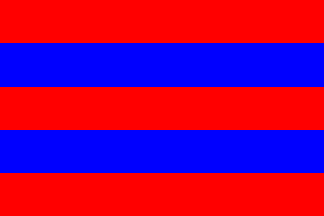![[Greek merchant ensign]](../images/g/gr~ott.gif)


Last modified: 2009-08-15 by ivan sache
Keywords: ottoman empire | civil ensign | smyrna | free greek republic | velestinlis-fereos (rigas) | mace (yellow) |
Links: FOTW homepage |
search |
disclaimer and copyright |
write us |
mirrors
See also:
Greek merchant ensign under the Ottoman rule (left) and its variant used in Smyrna (right) - Images by Ivan Sache, 10 March 2001
There were only three flags in the Ottoman
Empire that were official and so-called national flags:
the red with crescent and star as the national flag, the plain red as the merchant flag, and a special merchant flag for those who had done the pilgrimage to Mecca, a red flag with a green
central stripe.
That there might have been regulations on flags in Turkish
possessions is the fact that Greek ships had to fly a red flag with a
blue central stripe.
This flag is shown in
Colton's Delineation of Flags of All Nations (1862) (colour
plate reproduced by Znamierowski
[zna99]) and captioned: "#141.
Ottoman Greek".
Smith [smi75c] says: "The
Christians of Greece used a blue stripe through their red civil
ensign."
Ralf Stetler & Ivan Sache, 10 March 2001
The book Hellenic flags [kok97] mentions a variant of the merchant ensign used in Smyrna, red with two horizontal blue stripes.
Pascal Vagnat, 11 January 1999
Since the Treaty of Kioutsouk Kainartzi signed in 1774, Greek merchant vessels could (and did almost to the exclusion of any other flag until 1821) use the Russian naval ensign (St Andrew's cross). They even continued so throughout the 19th century when in Turkish waters.
Constantine Plakidas, 16 April 2003
Rigas' flag - Image by Eugene Ipavec, 6 May 2009
The flag of the Free Greek republic was designed by Rigas Velestinlis-Fereos in his revolutionary manifesto for the liberation of Greece (1797). The manifesto contains a Proclamation, a Constitution (strongly inspired by the French Constitution) and a revolutionary song called "Thurios". The only copy of the manifesto's manuscript, which has this flag on its last page, is found in the Library of the Romanian Academy, in Bucharest.
The flag, in proportions c. 3:5, is horizontally divided red-white-black with the yellow mace of Hercules in the middle.
Alex Danes & Paraskevas Renesis, 6 May 2009
The Naval Museum in Hania (Creta) shows a 16th-17th century flag found on an island in Souda Bay; the flag is blue with a white cross (the arms of the cross are one-third the width of the flag), with a green and brown laurel wreath in the middle of the cross.
Bruce Tindall, 20 May 1996